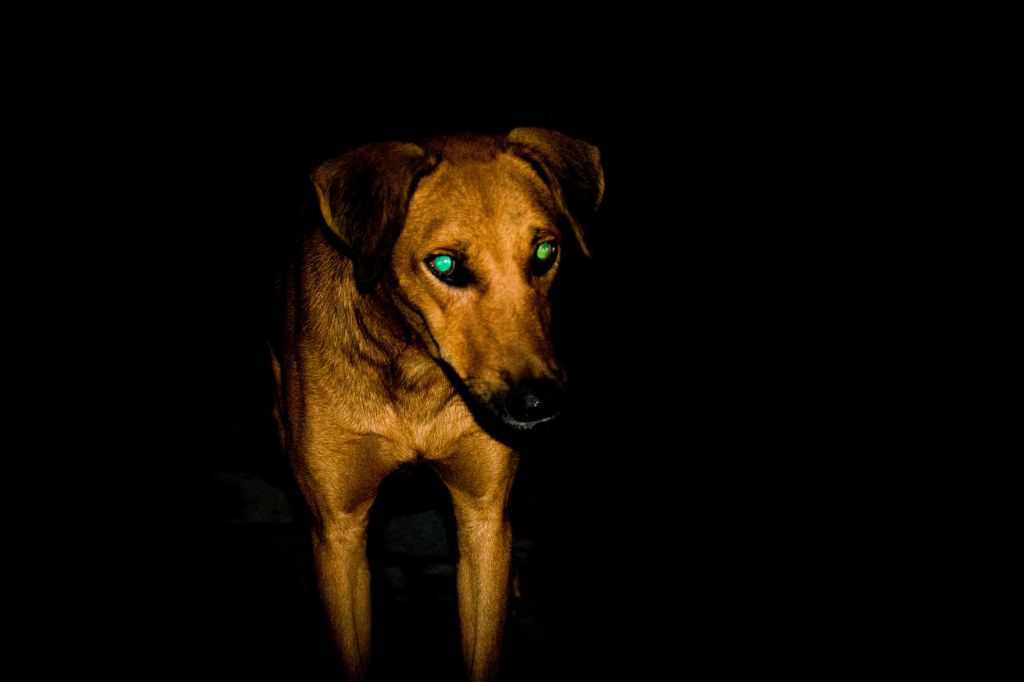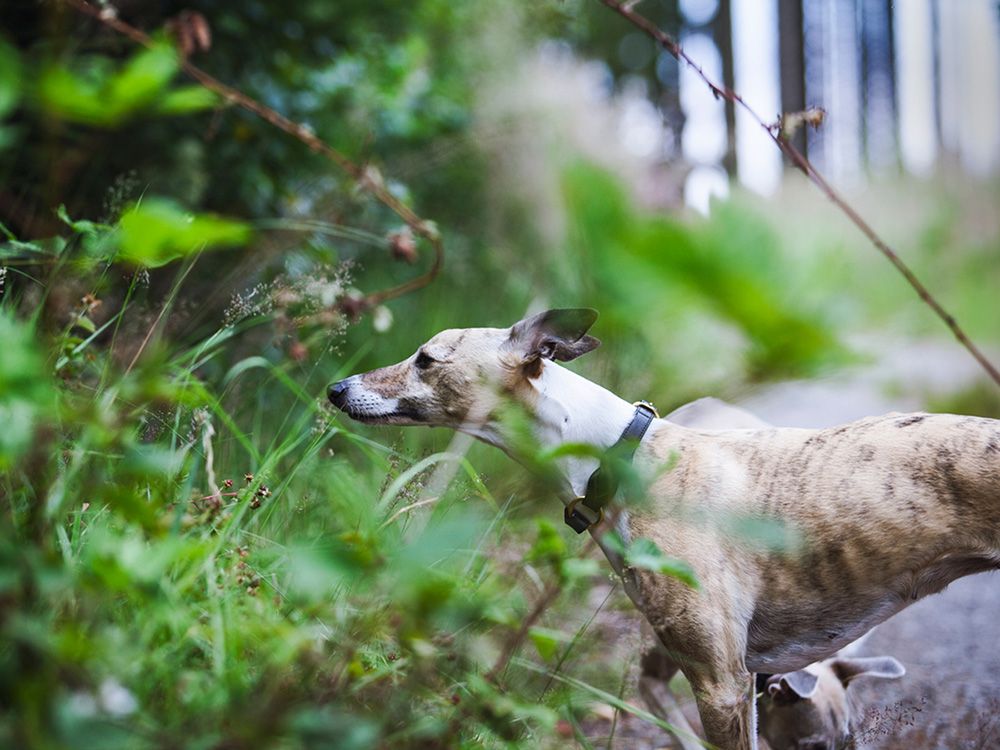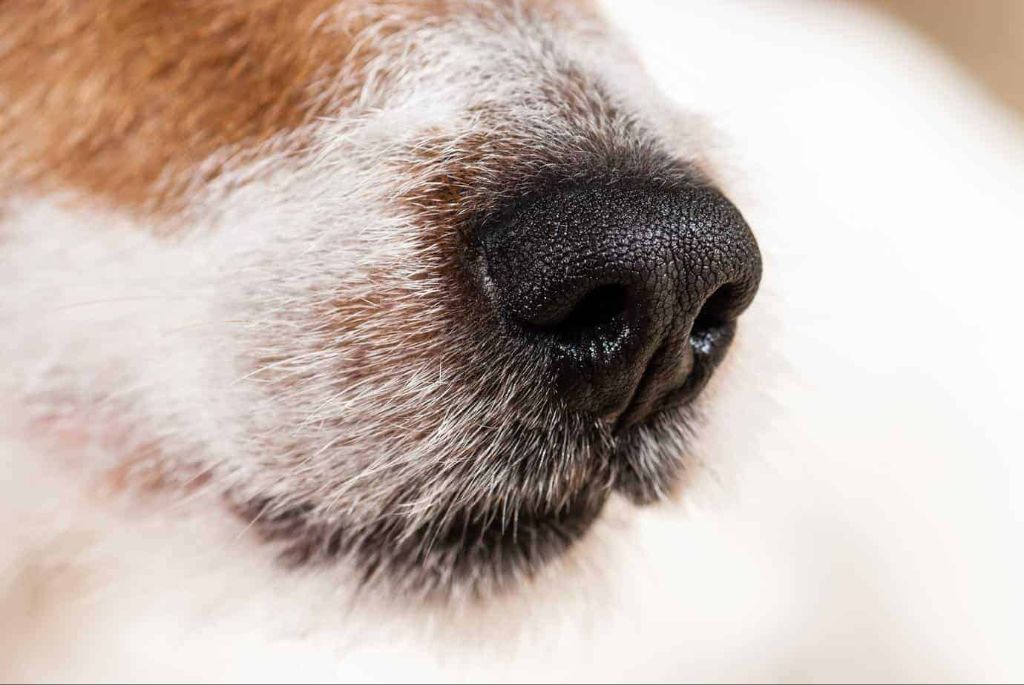Anatomy of the Canine Eye
A dog’s eye is made up of similar parts as a human eye, including the cornea, iris, pupil, lens, retina, and rods and cones. However, there are some key differences that give dogs better vision for their needs.
The cornea is the transparent outer layer of the eye that helps focus light. Dogs have a larger cornea relative to their eye size which gives them a wider field of vision [1].
Behind the cornea is the iris which controls how much light enters the eye by dilating or constricting the pupil. The pupil opening in dogs is much larger than in humans, allowing more light to reach the retina [2].
The lens focuses images on the retina which contains light-sensing rods and cones. Dogs have many more rods than humans which enables excellent night vision. They also have more cone types giving them better color discrimination [2].
Field of Vision
Dogs have a much wider field of vision compared to humans. While humans see about 180-200 degrees around them, dogs typically see 250-290 degrees – nearly a full circle! Dogs have excellent peripheral vision thanks to the side placement of their eyes in the skull. As Pets Doc notes, this wide field of view likely developed as an evolutionary advantage to spot predators while continuing to look forward.

Having near 360-degree vision allows dogs to see objects and movement all around them without needing to turn their head. It gives them a broader awareness of their environment. However, dogs do have a small blind spot in front of their nose and directly behind their heads where the fields of vision overlap. The wider field of view means dogs perceive the world differently than humans. They take in visual information from a much wider area, though with less detail directly in front. This impacts how dogs react to sights and sounds around them.
Color Perception
Dogs have dichromatic vision, meaning they have only two types of color receptor cones in their eyes. This allows them to see blue and yellow, but not red and green. Humans have trichromatic vision with three types of cones, able to perceive red, green, and blue light. This means dogs see a reduced color spectrum compared to humans.
Because dogs lack some color receptors, they cannot distinguish between certain hues that humans readily see as different colors. For example, dogs may confuse red and green items since these colors appear similar in their vision. Dogs also tend to be less responsive to reds and greens overall. Their visual spectrum is shifted towards dark blue, blueish-purple, yellow and various shades of gray.
Dogs’ limited color vision affects how they view our colorful human environments. What we see as vivid, saturated colors will often appear dull or faded to dogs. Their world consists of fewer distinct colors than ours. However, the colors dogs do see stand out more to them since their sight is attuned to contrasts of light and dark, movement and brightness.
Research shows that while dogs have fewer cones and reduced color perception compared to humans, their visual acuity for movement, brightness, and detecting contrasts is excellent. So dogs see a very different view of the world than we do, but their vision is optimized for their needs as hunters and scavengers.
Seeing Detail
A dog’s visual acuity, or ability to see fine detail, is less sharp compared to human vision. Research suggests that dogs have a visual acuity that is approximately 3 times lower than humans in both bright and dim light (Lind, 2017). This means dogs do not see objects as clearly from a distance. For example, what a person can clearly discern at 20 feet away, a dog would need to be closer, around 7 feet away, to see with the same level of sharpness (Daily Paws, 2022).
The structure of the canine eye contributes to their lower visual acuity. Dogs have less cone photoreceptor cells concentrated near the center of the retina compared to humans. Cones detect color and fine details, so fewer cones results in less visual sharpness (Petsdoc, n.d.). Additionally, dogs lack a fovea, which is a small central pit in the human retina packed with cones. The fovea gives humans sharp central vision.
While a dog’s vision may not be as sharp as a human’s, their eyes and brain have adapted to effectively take in visual information about their environment in other ways.
Low Light Vision
Dogs have excellent night vision compared to humans due to specialized anatomy in their eyes. They have a much higher concentration of rod photoreceptor cells in their retinas, which are more sensitive to light and motion than cone cells. While humans have about 120 million rod cells, dogs can have up to 300 million. This gives them superior vision in low light conditions.

In addition, dogs have a reflective layer behind their retinas called the tapetum lucidum that acts like a mirror to reflect light back through the retina, essentially giving light a second chance to be detected. This structure amplifies dim light up to 50% for dogs.
Furthermore, dogs’ pupils are larger and can dilate much wider than human pupils in the dark to let in more light. A human’s pupil dilates to a maximum of 8 mm, while a dog’s pupil can dilate to over 40 mm. This dramatically increases how much light reaches the retina and improves night vision acuity.
While humans struggle to see once it gets dark, dogs are able to clearly make out objects, movement, and textures thanks to their specialized night vision abilities. Their vision in dim light can be up to 5 times better than humans. So when we are bumping into furniture, dogs still have excellent visual perception and awareness of their surroundings.
Sources:
https://www.akc.org/expert-advice/lifestyle/can-dogs-see-in-the-dark/
https://www.petmd.com/dog/general-health/can-dogs-see-dark
Motion Perception

Dogs have superior motion perception compared to humans due to differences in their visual system. Dogs have a higher density of rod receptors in their retina, which are more sensitive to motion than cone receptors that detect color and detail (Source 1). This gives dogs better peripheral vision and ability to detect fast movement. Dogs have a flicker fusion rate (the rate at which a flashing light appears continuous) of 75Hz compared to 60Hz in humans, allowing them to better perceive motion (Source 2).
The high rod density and peripheral vision gives dogs a 270° field of vision compared to 180° in humans. This allows dogs to more quickly notice moving objects in their peripheral vision that humans would miss. The rod receptors also function better in low light than cone receptors. Overall, dogs evolved excellent motion detection to spot predators or prey when hunting.
Depth Perception
Dogs have less depth perception compared to humans due to their eyes being more spread apart on the sides of their heads. Humans have overlapping fields of vision from each eye which allows us to judge depth and distance very accurately (https://petsdoc.org/through-the-eyes-of-your-dog/). Dogs lack this binocular vision, so they don’t get the same 3D view of the world.
This impacts a dog’s ability to navigate obstacles and track moving objects. They can struggle with things like catching a ball in the air or walking down stairs. Without being able to clearly judge the distance to the ground, dogs may underestimate a drop-off or jump down from furniture incorrectly (https://www.cumberlandvetclinic.com/2022/03/15/what-do-dogs-see/). Their depth perception works best for objects directly in front of their nose.
To compensate, dogs rely more on their other senses. Their hearing helps identify where a sound is coming from. And their excellent sense of smell helps locate things in space. So while their depth perception is limited, dogs can still interact with their environment by combining information from sight, sound, and smell.
Visual Information Processing
Dogs process visual information differently than humans due to differences in their brains and visual systems. According to research, the visual cortex, which processes visual information, is much less developed in dogs compared to humans. Dogs only have about 1/6th the number of neurons in their visual cortex as primates do (Byosiere,2018: https://link.springer.com/article/10.3758/s13423-017-1404-7).
This means dogs do not have the same visual acuity and ability to see fine details that humans do. Their visual processing emphasizes motion detection over visual detail. As a result, dogs see flickering light much better than humans. The critical flicker fusion frequency, which measures the ability to detect flickering light, is about 75 Hz in dogs compared to only 60 Hz in humans (Psychology Today, 2022: https://www.psychologytoday.com/us/blog/canine-corner/202209/dogs-and-humans-interpret-what-they-see-differently). This allows dogs to more easily detect flickering light sources and sudden movements.
In summary, dogs process visual information with a priority on motion detection rather than visual detail. Their brains emphasize noticing movement, which aids hunting and survival, over discerning fine details.
Senses Working Together
A dog’s senses work together to create a fuller perception of their environment. Their excellent sense of smell combined with vision and hearing allows dogs to gather more information about their surroundings.

For example, a dog may catch a whiff of something interesting and turn their head towards the source based on the smell. They will then use their eyes to identify the object and their ears to pinpoint the location. Their nose tells them what it is, their eyes reveal what it looks like, and their ears indicate exactly where it is. This synergy between smell, sight, and hearing creates a multidimensional sensory experience.
Dogs also use their senses in conjunction when hunting. They may first detect the scent of prey on the wind. Then they will scan visually to try to spot the prey while turning their ears to listen for any sounds that may confirm the location. Their exceptional senses allow them to gradually zero in on their target.
A dog’s senses don’t operate in isolation. Sight, smell, and hearing work together to give dogs a rich perceptual understanding of their surroundings. Their senses complement each other and enable dogs to gather more nuanced information about their environment.
Seeing Through Your Dog’s Eyes
To put ourselves in our dogs’ paws and see the world through their eyes, we need to understand some key differences between human and canine vision. While our visual perception is dominated by detail, color, and acuity, dogs see the world very differently.
A dog’s vision is designed primarily for detecting motion and tracking movement. Their eyes have many more rod receptors which excel at night vision and following moving objects, but far fewer cone receptors for discerning color and details (https://petsdoc.org/through-the-eyes-of-your-dog/). Dogs see the world like a low-resolution, black and white video with heightened motion sensitivity.
In addition, dogs have a much wider field of view spanning 240-250 degrees compared to the 180 degree human range of vision. This gives them a panoramic perspective useful for monitoring threats, but with more visual blind spots directly in front of them (https://www.petbutler.com/blog-dog-eyes-canine-vision/). Their eyes are designed to detect motion and changes in their environment, not to stare straight ahead.
Understanding how dogs visually experience the world can help owners appreciate what captures their attention, startles them, or remains hidden from view. Simple steps like minimizing abrupt movements, allowing time for visual assessment of new environments, and engaging their motion-oriented perspective can greatly enrich a dog’s life.